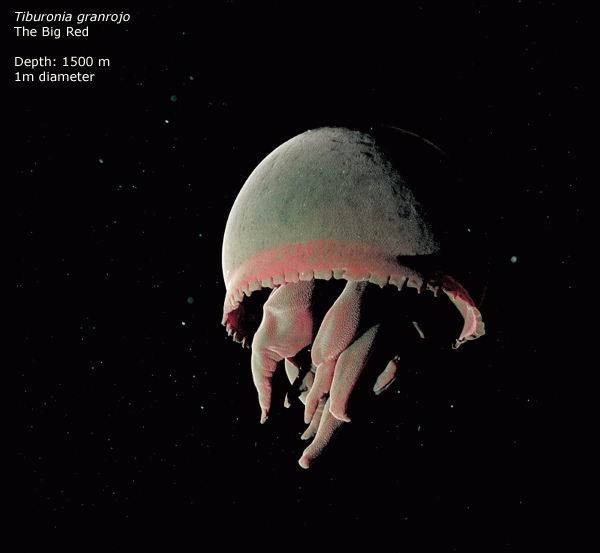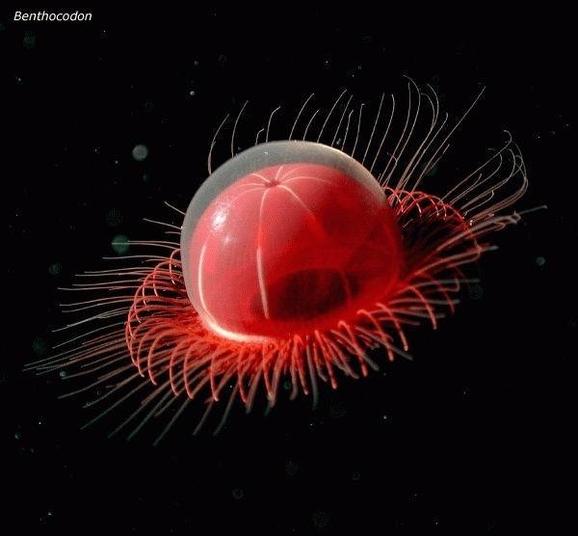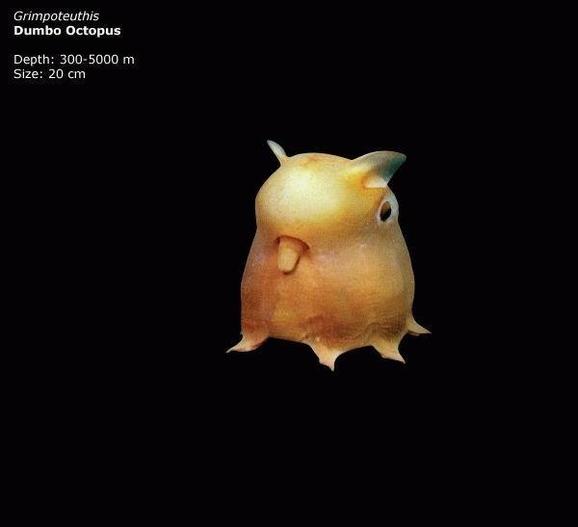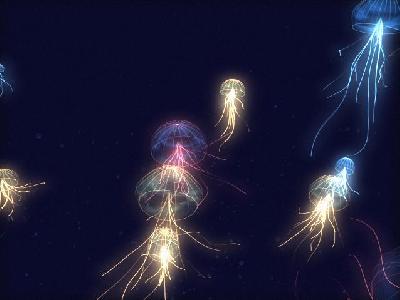It looks like you're using an Ad Blocker.
Please white-list or disable AboveTopSecret.com in your ad-blocking tool.
Thank you.
Some features of ATS will be disabled while you continue to use an ad-blocker.
share:
That little dumbo octopus is probably the deadliest and smartest creature down there. Being cute and squishy is it's snare.
I don't understand how the animals aren't crushed by the pressure..
Cameron is a beast! I love that man! Take a break from the movies and give us some real life excitment!
reply to post by NewAgeMan
The water in the cells and tissues of the fish is at the same pressure as the ambient (outside) pressure. Water is not compressible, and therefore there is no "room" in the body for anything to be crushed. While that explains why they can maintain their shape and structure, there are still many physiological (body chemistry) problems at that depth. These problems are caused primarily by proteins behaving differently at high pressures. Scientists continue to discover different ways that deep-sea fishes modify their proteins in order to help them function.
Here's an articla about how they survive the pressure. marinebio.org...
The water in the cells and tissues of the fish is at the same pressure as the ambient (outside) pressure. Water is not compressible, and therefore there is no "room" in the body for anything to be crushed. While that explains why they can maintain their shape and structure, there are still many physiological (body chemistry) problems at that depth. These problems are caused primarily by proteins behaving differently at high pressures. Scientists continue to discover different ways that deep-sea fishes modify their proteins in order to help them function.
Here's an articla about how they survive the pressure. marinebio.org...
reply to post by primus2012
Kind of like those little dinosaurs in Jurrasic Park that killed the fat guy in the jeep.....alll cute and cooing to get you to let your guard down....then transforms to a bloodthirsty killer......aggggggggg!!!!!!!!!!!!!!
That little dumbo octopus is probably the deadliest and smartest creature down there. Being cute and squishy is it's snare.
Kind of like those little dinosaurs in Jurrasic Park that killed the fat guy in the jeep.....alll cute and cooing to get you to let your guard down....then transforms to a bloodthirsty killer......aggggggggg!!!!!!!!!!!!!!
Just think of the wild life that didn't get pictured due to photo sensitivity. There could be some real creepy crawlies down there that just didn't
come out because of the lights on the sub. Some of those creatures have only ever experienced darkness in such low depths.
reply to post by StealthyKat
wow, nice thread stealthykat.
thanks for the response in anon72's thread, somehow I missed yours here.
fantastic pics ! love the Dumbo Octopus like a lot of others on here...
can't wait to see the pics of James Cameron's dive.
wow, nice thread stealthykat.
thanks for the response in anon72's thread, somehow I missed yours here.
fantastic pics ! love the Dumbo Octopus like a lot of others on here...
can't wait to see the pics of James Cameron's dive.
Originally posted by StealthyKat
reply to post by Jomina
I know! It almost looks like it could be a child's toy! Cute....
That's Funny as soon as I saw it, I was like how cute!! I want a fish take full of them....then my mind had to start to work on how you could set up a pressurized fish tank so they could live....I may have a new mission!
I'm surprised no one has said this yet, but....
This is obviously the resting place of Cthulu. If those fishes aren't proof....well, something.
This is obviously the resting place of Cthulu. If those fishes aren't proof....well, something.
Originally posted by StealthyKat
reply to post by SheeplFlavoredAgain
Some are scary, some are cute, and some look like living electricity flashing colored lights.....it's just amazing. Imagine what else could be down there that we HAVEN'T seen yet!
imagine what we kill everyday on this planet that we will never know about.
the life on the bottom of the ocean almost looks fake. i love it!
Originally posted by Blarneystoner
Watching this story on the news this AM I couldn't help but think that science would have been better served if an actual Marine Biologist was in the Sub.... the only thing served by this was Cameron's ego...
Science was served by the technology, money and guts that Cameron mustered to get that sub into the depths.
A marine biologist would be just added useless baggage. All the biologist could do is look out the window, just like Cameron. Since it will all be recorded, the biologist gets a lot of great research for free, and no risk.
reply to post by charlyv
seeing something on a screen and being there are two very different things.... your perspective is effected greatly and you are inclined to notice different and generally more things
actually being there first hand is ALWAYS more desirable
if what you said had any validity at all james cameron would have had someone go in his place because hey theres no benefit to actually going yourself
but yes sience was served nobody would have been willing to pay for this otherwise (which is down right criminal when you look at the amounts being spent on petty bull# that will not help humanity in any way shape or form) hopefully things like this will get more funding because of it
seeing something on a screen and being there are two very different things.... your perspective is effected greatly and you are inclined to notice different and generally more things
actually being there first hand is ALWAYS more desirable
if what you said had any validity at all james cameron would have had someone go in his place because hey theres no benefit to actually going yourself
but yes sience was served nobody would have been willing to pay for this otherwise (which is down right criminal when you look at the amounts being spent on petty bull# that will not help humanity in any way shape or form) hopefully things like this will get more funding because of it
edit
on 28-3-2012 by sirhumperdink because: (no reason given)
Excellent thread! I love stuff like this. The photos and vids are great--I love how deep-sea life has such a high weirdness factor. And yeah, the
little octo-thingie everyone thinks is so adorable rates very high on the weirdness chart(it looks like a plushie and even has the 'fake' eye
markings!)
As I read through all the responses, I noticed the "why do we know more about outer space than our own oceans?" question was brought up. I have some thoughts of my own on this.
First I would say, "space" is mostly empty space, and wherever it is not empty space, some of the stuff filling it up has a tendency to coalesce into stars, which then conveniently light up all the stuff that didn't turn into stars. So we know a lot about space(or the stuff in space) because we can see lots of it simply by walking outside at night and looking up. It also greatly simplified the engineering problems involved in building tools to study space. The tools merely needed to 1) Sit relatively still, and 2) Help you look at space.
The oceans only let us see their surfaces, for the most part. Even when the water is very clear, diffraction will not allow the passage of enough visible light to illuminate the really interesting parts. A great deal of our deep-sea knowledge comes from sonar or radar, both of which are a method of 'looking' at things by sending out a signal, then analyzing the returning echoes--a difficult task even when you know what your signal is bouncing off of.
The second major difference is the change in environment. Air pressure at sea-level is approximately 15psi. Air pressure in space is approximately 0psi. Not a large difference. Average pressure at the bottom of the Marianas Trench is approximately 18,000psi. Rather a large difference.
So even though the bottoms of our oceans are much closer than even low-earth-orbit space in terms of distance, they are much, much farther away in terms of pressure difference. Any of the myriad successful vehicles the human race has launched into space, if subjected to the pressures of the ocean depths, would crumple into a little tiny ball of fail. Our materials technology, metallurgy, and structural science has needed time to advance in order to tackle the pressure problem.
There's my two cents on that subject.
Now, back to the awesome photos posted in this thread...I've never seen most of these! I knew about the anglers, and the dragonfish. The rest are totally new to me. This gives me a chance to show off what I've learned about analyzing weird photos on ATS:
This is actually a super-secret NASA image that was mistakenly filed with NUMA(National Underwater and Marine Agency). It is one of a series of images taken by an automated probe sent to Venus. This is what the probe saw as it began to swing around to the far side of Venus, which we never see from earth...and now we know why!! It's not a planet, its a....well it's not a planet!!! (if you think this is not a space pic, look again...those are STARS in the bg)
I could make this in Photoshop in 5 minutes. Nice try.
So I'm supposed to believe that somebody spent millions of dollars building a contraption to take them to a place where the environment is so extreme that the slightest flaw in the equipment would mean instant death, and as proof of the trip they show us a very clear photo of what they claim is an unknown life form(a life form that bears a striking resemblance to a certain type of plushie toy, btw). The background of the pic is solid black. The explanation given for this is that "it's very dark down there." Ok, then how did they find this thing if it's so dark, 20cm is not very big. Also, it's dark in my room at night when the lights are out, but my cheap digital camera manages to pick up lots of bg details with its little flash.
Occam's Razor says: This is actually a doctored pic of a plushie toy, no human has ever been to the bottom of the Mariana Trench, this whole thing is a hoax.
Psshh. These are obviously chinese lanterns.
That was fun.
As I read through all the responses, I noticed the "why do we know more about outer space than our own oceans?" question was brought up. I have some thoughts of my own on this.
First I would say, "space" is mostly empty space, and wherever it is not empty space, some of the stuff filling it up has a tendency to coalesce into stars, which then conveniently light up all the stuff that didn't turn into stars. So we know a lot about space(or the stuff in space) because we can see lots of it simply by walking outside at night and looking up. It also greatly simplified the engineering problems involved in building tools to study space. The tools merely needed to 1) Sit relatively still, and 2) Help you look at space.
The oceans only let us see their surfaces, for the most part. Even when the water is very clear, diffraction will not allow the passage of enough visible light to illuminate the really interesting parts. A great deal of our deep-sea knowledge comes from sonar or radar, both of which are a method of 'looking' at things by sending out a signal, then analyzing the returning echoes--a difficult task even when you know what your signal is bouncing off of.
The second major difference is the change in environment. Air pressure at sea-level is approximately 15psi. Air pressure in space is approximately 0psi. Not a large difference. Average pressure at the bottom of the Marianas Trench is approximately 18,000psi. Rather a large difference.
So even though the bottoms of our oceans are much closer than even low-earth-orbit space in terms of distance, they are much, much farther away in terms of pressure difference. Any of the myriad successful vehicles the human race has launched into space, if subjected to the pressures of the ocean depths, would crumple into a little tiny ball of fail. Our materials technology, metallurgy, and structural science has needed time to advance in order to tackle the pressure problem.
There's my two cents on that subject.
Now, back to the awesome photos posted in this thread...I've never seen most of these! I knew about the anglers, and the dragonfish. The rest are totally new to me. This gives me a chance to show off what I've learned about analyzing weird photos on ATS:
This is actually a super-secret NASA image that was mistakenly filed with NUMA(National Underwater and Marine Agency). It is one of a series of images taken by an automated probe sent to Venus. This is what the probe saw as it began to swing around to the far side of Venus, which we never see from earth...and now we know why!! It's not a planet, its a....well it's not a planet!!! (if you think this is not a space pic, look again...those are STARS in the bg)
I could make this in Photoshop in 5 minutes. Nice try.
So I'm supposed to believe that somebody spent millions of dollars building a contraption to take them to a place where the environment is so extreme that the slightest flaw in the equipment would mean instant death, and as proof of the trip they show us a very clear photo of what they claim is an unknown life form(a life form that bears a striking resemblance to a certain type of plushie toy, btw). The background of the pic is solid black. The explanation given for this is that "it's very dark down there." Ok, then how did they find this thing if it's so dark, 20cm is not very big. Also, it's dark in my room at night when the lights are out, but my cheap digital camera manages to pick up lots of bg details with its little flash.
Occam's Razor says: This is actually a doctored pic of a plushie toy, no human has ever been to the bottom of the Mariana Trench, this whole thing is a hoax.
Psshh. These are obviously chinese lanterns.
That was fun.
These creatures were probobly so photo sensitive that he basicly murdered every animal he came across.
if those eyes werent already useless.... they are now....
if those eyes werent already useless.... they are now....
LOL @ phto-sensitve comment, probably a lot to that !
Such a great thread, thank you vey much. Who needs to wonder about life on other planets when our own is still such a mystery
Maybe you guys in America need the National Aquanautics and Terran Agency instead of NASA ;+]
Such a great thread, thank you vey much. Who needs to wonder about life on other planets when our own is still such a mystery
Maybe you guys in America need the National Aquanautics and Terran Agency instead of NASA ;+]
new topics
-
Planned Civil War In Britain May Be Triggered Soon
Social Issues and Civil Unrest: 17 minutes ago -
Claim: General Mark Milley Approved Heat and Sound Directed Energy Weapons During 2020 Riots
Whistle Blowers and Leaked Documents: 1 hours ago
top topics
-
Claim: General Mark Milley Approved Heat and Sound Directed Energy Weapons During 2020 Riots
Whistle Blowers and Leaked Documents: 1 hours ago, 2 flags -
Planned Civil War In Britain May Be Triggered Soon
Social Issues and Civil Unrest: 17 minutes ago, 0 flags
active topics
-
Sorry to disappoint you but...
US Political Madness • 36 • : KrustyKrab -
Gravitic Propulsion--What IF the US and China Really Have it?
General Conspiracies • 25 • : Lazy88 -
Claim: General Mark Milley Approved Heat and Sound Directed Energy Weapons During 2020 Riots
Whistle Blowers and Leaked Documents • 6 • : rickymouse -
The Truth about Migrant Crime in Britain.
Social Issues and Civil Unrest • 22 • : Cymru -
Trudeau Resigns! Breaking
Mainstream News • 69 • : KrustyKrab -
Planned Civil War In Britain May Be Triggered Soon
Social Issues and Civil Unrest • 0 • : TimBurr -
Stuck Farmer And His Queue Jumping Spawn
Rant • 10 • : Cvastar -
Joe Biden gives the USA's Highest Civilian Honor Award to Hillary Clinton and George Soros.
US Political Madness • 59 • : mysterioustranger -
Greatest thing you ever got, or bought?
General Chit Chat • 24 • : mysterioustranger -
Post A Funny (T&C Friendly) Pic Part IV: The LOL awakens!
General Chit Chat • 7998 • : underpass61




